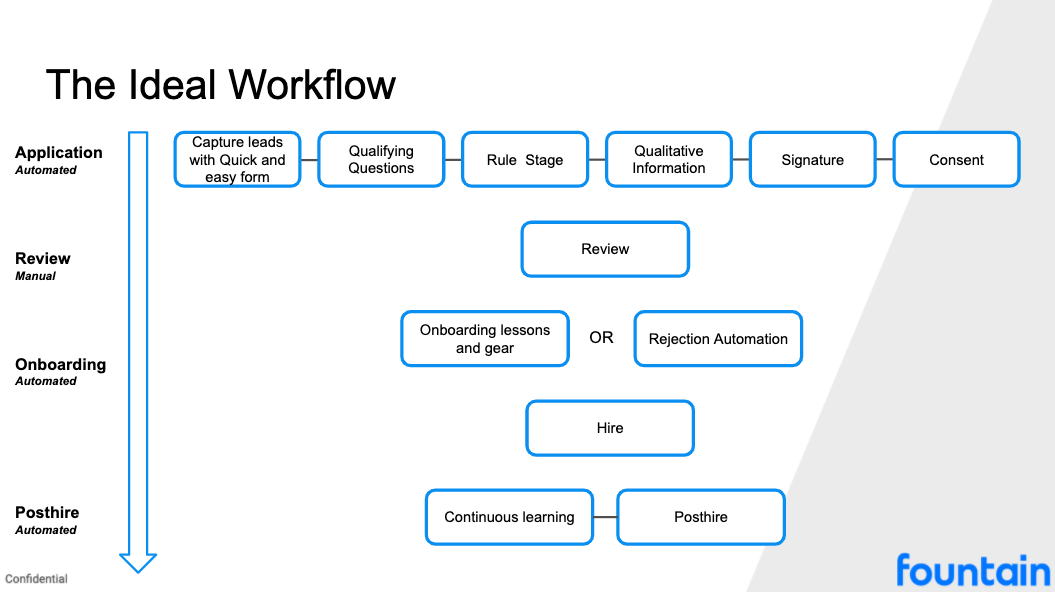We recently had an awesome webinar with Food On Demand News, where Tom Kaiser, the Editor at the publication, interviewed Nico Roberts, Fountain’s Head of Global Customer Success and Strategy. Tom and Nico got into the critical details on things like what the current hiring market looks like, the ideal structure of the hiring process for hourly workers, the things that typically cause employee churn, and much more. Check out some highlights from the conversation below:
TK: Nico, my first question is a general one: what’s the current environment like for employers looking to hire new or bring back employees? The unemployment rate is certainly higher now than it’s been in years… is this an employer’s or a job seeker’s market at this point?
NR: Great question, Tom! I’d probably say depending on your industry, it could go either way. What we’re seeing is there are companies out there, specifically on-demand delivery companies, that are exploding, having 10x, 20x growth, and there’s a lot of demand out there for their products and all services, but then some of the brick and mortar individuals, because of all the Covid restrictions in place, we are seeing a reduction in hiring, and therefore, also from an applicant standpoint, a lot of applicants are going to where the growth is and incentives, and right now is a lot of the on-demand and gig workforce.
TK: That makes a lot of sense from my perch here at Food on Demand. It’s such an interesting situation where the restaurant industry has been so strongly impacted, but the on-demand subset of the restaurant industry is one of the primary growth areas in the entire US economy.
You’ve said that your team breaks up the high-volume hiring process into three main parts: sourcing, screening and post hire, which ropes in onboarding and activation of new hires, as well… How do these three different buckets work for clients who haven’t worked with Fountain before or are entirely new to high-volume?
NR: Definitely, So as you mentioned, we sort of divi everything up into those three main buckets, and each of those main buckets, 1. Sourcing’ 2. Screening, the big chunk as you go through; and then 3. Post-hire, once you’ve made the decision of “go” or “no go” on the applicant; each of them deserves the same amount of attention because each of them is equally as important. So on the sourcing side, right, whether it’s job boards, whether it’s organic traffic from your website, whether it’s internal employee referrals or 1099 referrals, at some point, you’re going to have applicants flow through. So you, or your marketing team, or whatever team’s in charge of sourcing those applicants need to be able to track the source – where they’re coming from – if you have multiple different campaigns going, there’s verbiage differences, color differences, branding differences, you need to be able to track that down as well to measure the success rates and then have that all flow in. In Fountain, we take all that data, and we integrate with job boards, we work with your teams to set that up, and as the applicants flow through, we have a wealth of knowledge and a rich lead as it comes in so we can tell you ‘Hey on this campaign, you had 5 applicants come in, and on the other one you had 500, so that’s probably a good campaign to go with.’ So on the sourcing side, getting the applicants on the top of funnel is really important.
Now once you’ve spent all that time bringing them in, the next one is how do you make sure you retain them in the hiring flow? What we’ve seen is from the time an applicant actually applies, they fill out what they need to fill out and hit apply button, you have 12 hours on average to get that applicant interested, otherwise you’ve lost them…
TK: That’s crazy!
NC: I know! We see it all the time. If you don’t act in those first 12 hours, the applicant’s gone. Because the applicant is applying to your position as well as 10 others down the road, and the first person that gets back to them, that feels more like a human touch, where the applicant can connect with the brand… that’s where their focus goes.
So at Fountain, the first thing we do is as soon as they apply, immediately we send emails and text messages that says ‘Hello Susie, I know it’s raining, I’m sure you’ve applied to 12 other spots, but we’d love to have a chat with you.” And that immediately makes Susie all excited because she’s getting a response, she’s just filled out a bunch of application forms, had to create usernames and passwords online, or she’s had to stand in a line and hand in her application form to a hiring manager… it’s a bit of a cumbersome process.
So you have 12 hours, and once they’re in, you have to make sure the applicant is moving through the process, they have to have the sense of progression. If they don’t have that sense, they tend to lose interest.
Check out the image below for the Ideal Hiring Workflow:


